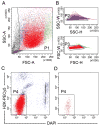Removal of lactate dehydrogenase-elevating virus from human-in-mouse breast tumor xenografts by cell-sorting
- PMID: 21354210
- PMCID: PMC3086718
- DOI: 10.1016/j.jviromet.2011.02.015
Removal of lactate dehydrogenase-elevating virus from human-in-mouse breast tumor xenografts by cell-sorting
Abstract
Lactate dehydrogenase-elevating virus (LDV) can infect transplantable mouse tumors or xenograft tumors in mice through LDV-contaminated mouse biological materials, such as Matrigel, or through mice infected with LDV. LDV infects specifically mouse macrophages and alters immune system and tumor phenotype. The traditional approaches to remove LDV from tumor cells, by transplanting tumors into rats or culturing tumor cells in vitro, are inefficient, labor-intensive and time-consuming. Furthermore, these approaches are not feasible for primary tumor cells that cannot survive tissue culture conditions or that may change phenotype in rats. This study reports that fluorescence-activated cell sorting (FACS) is a simple and efficient approach for purifying living primary human breast tumor cells from LDV(+) mouse stromal cells, which can be completed in a few hours. When purified from Matrigel contaminated LDV(+) tumors, sorted human breast tumor cells, as well as tumors grown from sorted cells, were shown to be LDV-free, as tested by PCR. The results demonstrate that cell sorting is effective, much faster and less likely to alter tumor cell phenotype than traditional methods for removing LDV from xenograft models. This approach may also be used to remove other rodent-specific viruses from models derived from distinct tissues or species with sortable markers, where virus does not replicate in the cells to be purified.
Copyright © 2011 Elsevier B.V. All rights reserved.
Conflict of interest statement
Figures


Similar articles
-
Replication of lactate dehydrogenase-elevating virus in various species cell lines infected with dual-, ampho- and xenotropic murine leukaemia viruses in vitro.Virus Res. 1993 Mar;27(3):267-81. doi: 10.1016/0168-1702(93)90038-o. Virus Res. 1993. PMID: 8387719
-
Detection of lactate dehydrogenase-elevating virus in transplantable mouse tumors by biological assay and RT-PCR assays and its removal from the tumor cell.J Virol Methods. 1997 May;65(2):227-36. doi: 10.1016/s0166-0934(97)02188-5. J Virol Methods. 1997. PMID: 9186946
-
Isolation of lactate dehydrogenase-elevating viruses from wild house mice and their biological and molecular characterization.Virus Res. 2000 Apr;67(2):153-62. doi: 10.1016/s0168-1702(00)00142-8. Virus Res. 2000. PMID: 10867194
-
Comparison of the ability of lactate dehydrogenase-elevating virus and its virion RNA to infect murine leukemia virus-infected or -uninfected cell lines.J Virol. 1993 Sep;67(9):5698-703. doi: 10.1128/JVI.67.9.5698-5703.1993. J Virol. 1993. PMID: 8394468 Free PMC article.
-
Detection of Lactate Dehydrogenase Elevating Virus in a Mouse Vivarium Using an Exhaust Air Dust Health Monitoring Program.J Am Assoc Lab Anim Sci. 2020 May 1;59(3):328-333. doi: 10.30802/AALAS-JAALAS-19-000107. Epub 2020 Feb 20. J Am Assoc Lab Anim Sci. 2020. PMID: 32079556 Free PMC article.
Cited by
-
Establishing and Maintaining an Extensive Library of Patient-Derived Xenograft Models.Front Oncol. 2018 Feb 19;8:19. doi: 10.3389/fonc.2018.00019. eCollection 2018. Front Oncol. 2018. PMID: 29515970 Free PMC article.
-
Flourishing tumor organoids: History, emerging technology, and application.Bioeng Transl Med. 2023 Jun 7;8(5):e10559. doi: 10.1002/btm2.10559. eCollection 2023 Sep. Bioeng Transl Med. 2023. PMID: 37693042 Free PMC article. Review.
-
Advances in Organoid Culture Research.Glob Med Genet. 2022 Dec 14;9(4):268-276. doi: 10.1055/s-0042-1756662. eCollection 2022 Dec. Glob Med Genet. 2022. PMID: 36530528 Free PMC article. Review.
-
The Impact of the Cellular Environment and Aging on Modeling Alzheimer's Disease in 3D Cell Culture Models.Adv Sci (Weinh). 2023 Mar;10(8):e2205037. doi: 10.1002/advs.202205037. Epub 2023 Jan 15. Adv Sci (Weinh). 2023. PMID: 36642841 Free PMC article. Review.
-
Biopolymers for Liver Tissue Engineering: A Systematic Review.Gels. 2025 Jul 7;11(7):525. doi: 10.3390/gels11070525. Gels. 2025. PMID: 40710688 Free PMC article. Review.
References
-
- Infectious disease of mice and rats, Institute for Laboratory Animal Resources ed. National Academy Press; Washington, D.C:
-
- Anderson GW, Even C, Rowland RR, Palmer GA, Harty JT, Plagemann PG. C58 and AKR mice of all ages develop motor neuron disease after lactate dehydrogenase-elevating virus infection but only if antiviral immune responses are blocked by chemical or genetic means or as a result of old age. J Neurovirol. 1995;1:244–52. - PubMed
-
- Baker DG. Natural Pathogens of laboratory Animals: Their effects on research. ASM Press; Washington, D.C: 2003.
Publication types
MeSH terms
Grants and funding
LinkOut - more resources
Full Text Sources
Medical

